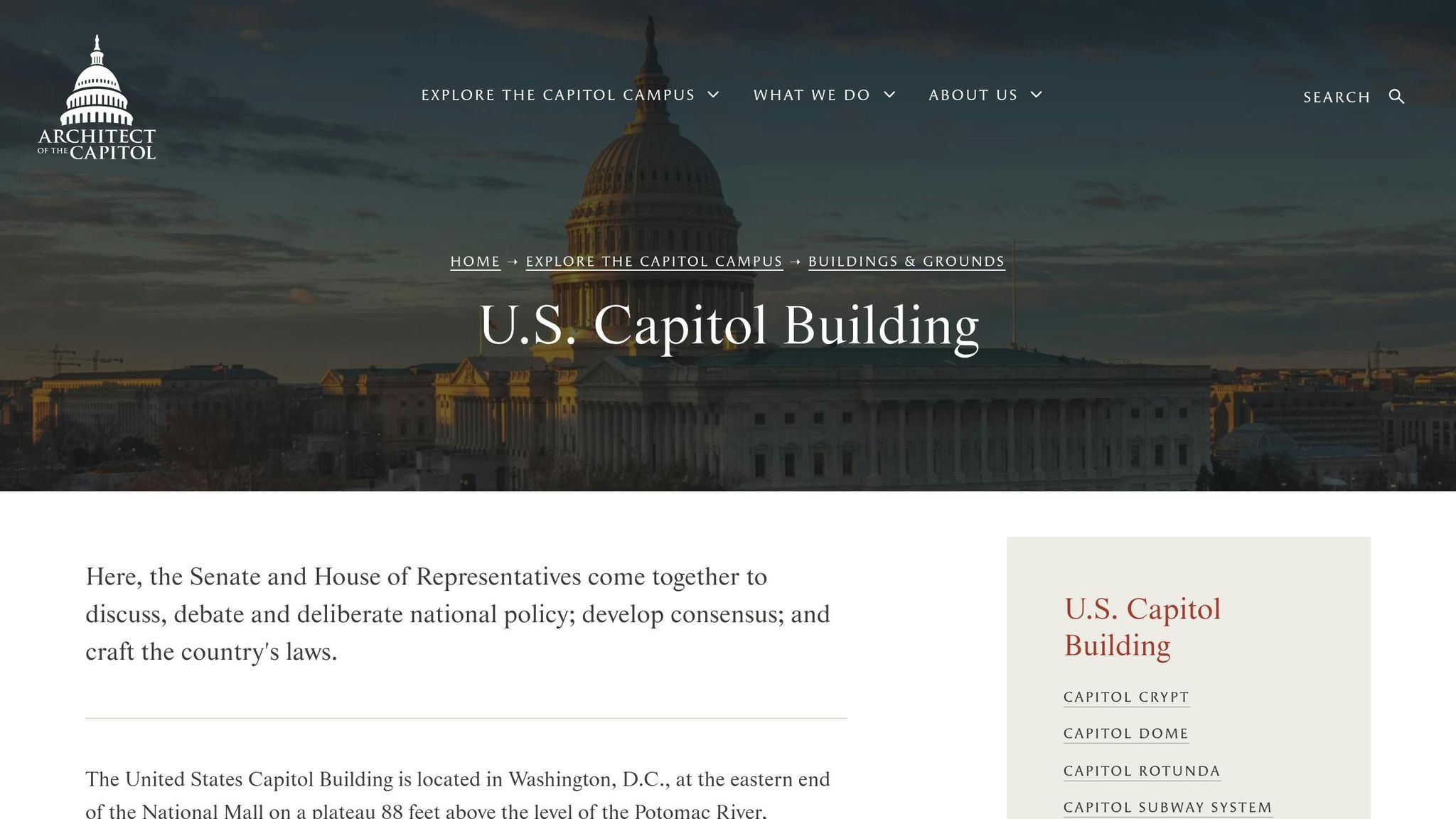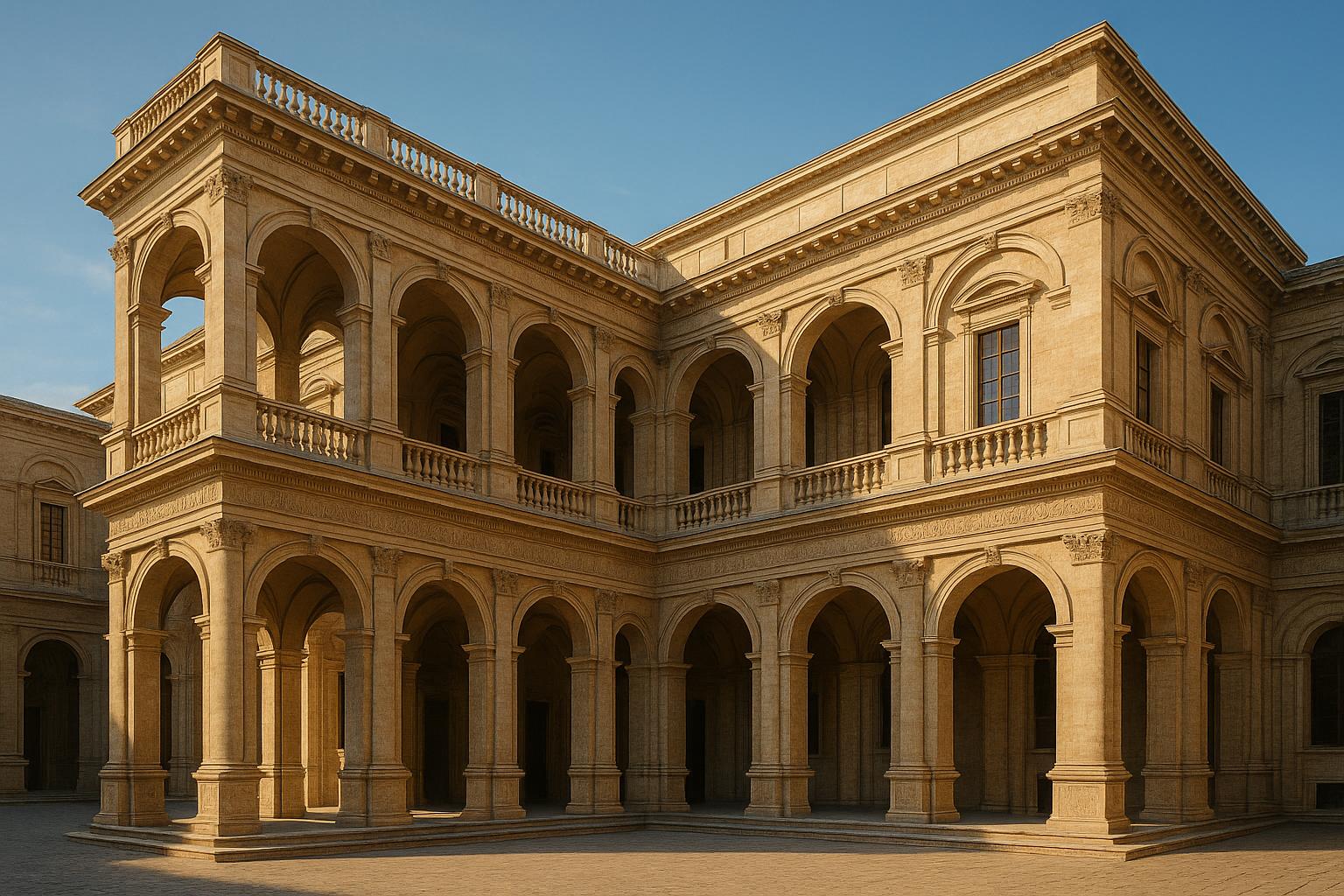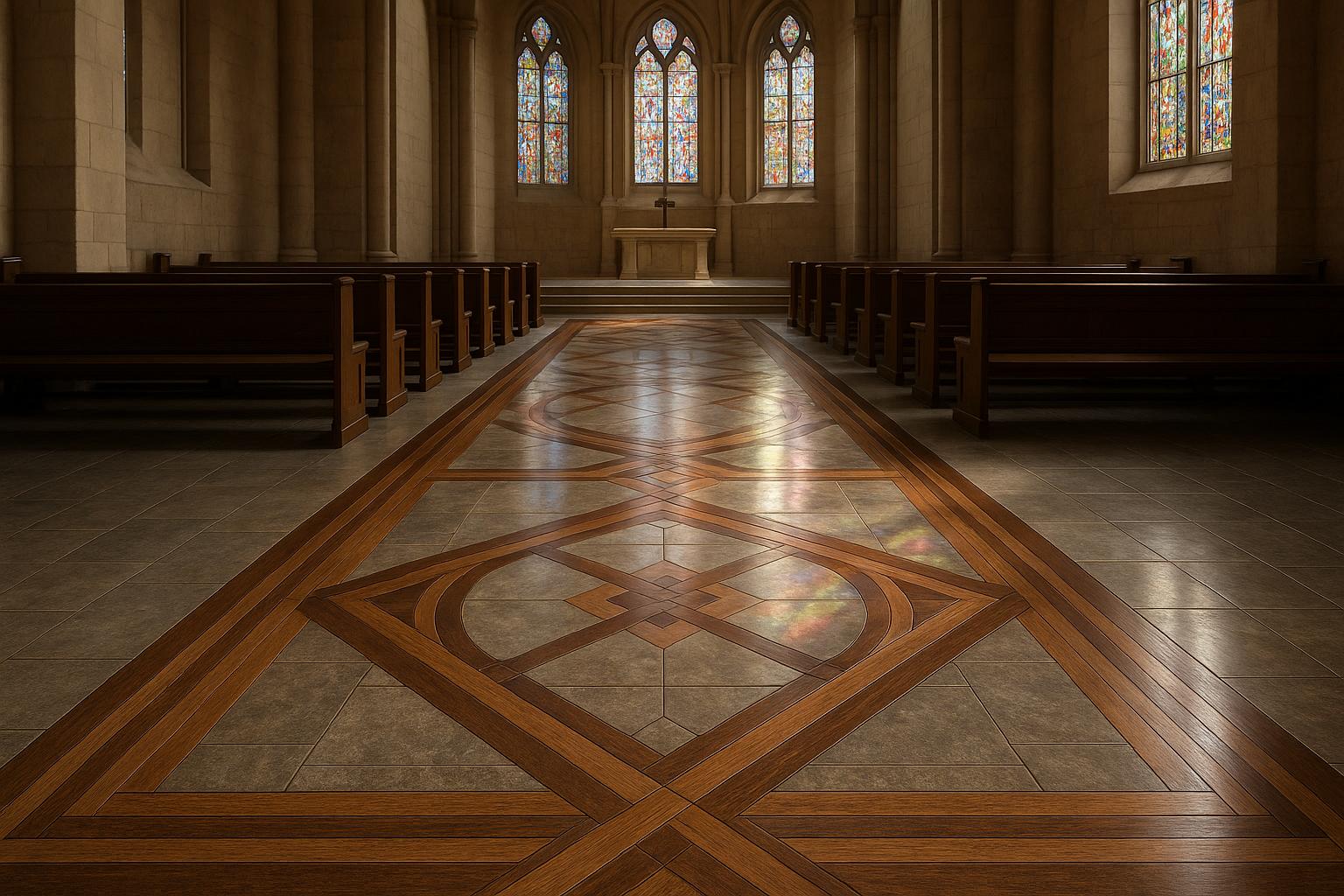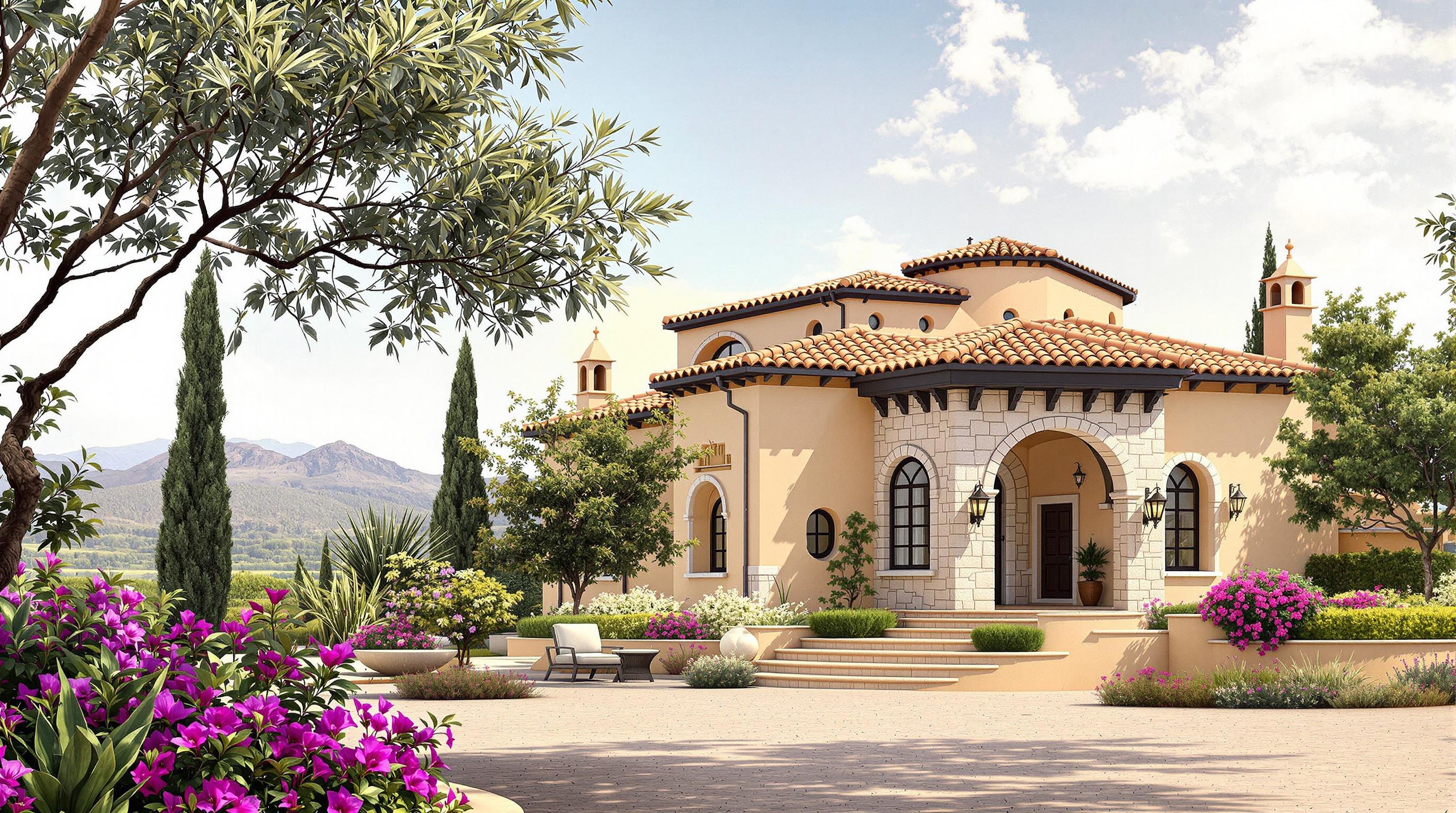Civic architecture goes beyond functionality - it tells stories about shared history, values, and identity. This article explains how symbols in civic buildings reflect democratic ideals, local pride, and historical narratives. Here's a quick summary:
- National Symbols: Eagles, flags, and seals highlight unity and patriotism.
- Historical References: Columns, indigenous patterns, and inscriptions connect to the past.
- Local Identity: Materials, flora, fauna, and industry motifs tie buildings to their communities.
- Architectural Elements: Domes, columns, and arches symbolize governance and unity.
- Modern Trends: Architects focus on representation, sustainability, and preserving historic elements while meeting current needs.
Civic buildings blend design with meaning, creating spaces that inspire connection and participation in governance.
Reading Between the Buildings: The Secret Symbolism of Architecture
Common Types of Symbols in Civic Architecture
Civic buildings in the United States often use symbols to communicate shared values and tell a story about national pride, historical connections, and local identity. These symbols help citizens feel connected to their government, history, and community, creating a sense of belonging and purpose. Let’s explore three key categories of symbols commonly found in civic architecture.
National Symbols
Civic architecture frequently incorporates symbols of national unity and patriotism. Eagles, flags, and official seals are some of the most recognizable elements. The bald eagle, representing strength and freedom, is a common sight on facades, entrances, and domes. Whether carved in stone or cast in bronze, it embodies the enduring spirit of American democracy.
The Great Seal of the United States is another prominent feature, appearing in courthouses and other federal buildings. Often displayed above main entrances or integrated into architectural details, the seal reinforces the authority and identity of the government. State and local civic buildings may also include their own seals alongside national ones, adding a layer of regional pride.
The American flag motif is woven into architectural design in creative ways. From star patterns in floor tiles to striped stonework, these elements often reference the original thirteen colonies, blending history with patriotic symbolism. Additionally, shield and banner designs carved into buildings signal protection and authority, linking local governance to national ideals.
Historical References
History plays a key role in civic architecture, with designs that pay tribute to democratic ideals and cultural heritage. Neoclassical columns, for instance, are a nod to ancient Greek and Roman civilizations - the birthplace of democracy. Doric, Ionic, and Corinthian columns are widely used in courthouses and federal buildings, creating a visual connection to these historical roots.
In recent years, indigenous cultural patterns have become more prominent, particularly in areas with significant Native American heritage. Southwestern courthouses and Pacific Northwest buildings often feature tribal motifs and geometric designs, honoring the land’s original inhabitants and embracing cultural diversity.
Colonial-era references are another common theme, seen in architectural styles like Georgian and Federal designs, red brick exteriors, and white-painted wooden details. Many civic buildings also include historic inscriptions, such as quotes from founding fathers, key dates, or passages from the Constitution, carved directly into their facades.
Local history is celebrated through commemorative plaques, relief sculptures, and decorative elements that highlight regional milestones. From Civil War monuments in courthouse squares to pioneer-themed designs or industrial heritage symbols, these features reflect each community’s unique story.
Community and Local Identity
Symbols rooted in local identity give civic buildings a personal touch, connecting them to the regions they serve. Native materials, such as locally sourced stone or wood, help tie architecture to the surrounding landscape while supporting local economies. These materials create a sense of place and belonging.
Regional flora and fauna frequently appear as decorative motifs. In California, buildings might feature grapevine carvings or poppy designs, while Midwest courthouses display corn and wheat patterns. In mountain states, you’ll find pine cone and elk imagery, while coastal areas often incorporate seashells and maritime symbols.
Local industry symbols are another way civic buildings honor their communities. Mining towns might include pickaxe and ore cart motifs, agricultural regions display farming tools, and manufacturing hubs incorporate gears and factory imagery. These designs celebrate the industries that shaped the community’s identity.
Cultural markers showcase America’s multicultural heritage. Buildings in areas with German roots might include traditional European patterns, while regions with strong Hispanic influences often feature Spanish colonial elements and colorful tile work. These details reflect the diverse backgrounds of the people who live there.
Finally, geographic features unique to each region often inspire architectural elements. Stylized representations of mountains, rivers, or other landmarks appear in everything from metalwork to murals, creating a visual connection between civic buildings and their natural surroundings. These symbols reinforce the bond between architecture, community, and the environment.
How Architects Add Symbols to Civic Buildings
Architects play a crucial role in embedding symbols into civic buildings, using design elements to convey cultural values and civic identity. They achieve this through three primary approaches: structural elements that inherently symbolize ideas, decorative features that tell visual stories, and spatial designs that foster emotional connections. Each method contributes uniquely to how civic buildings communicate their purpose and significance to the public.
Structural Elements
Structural elements like columns, domes, arches, and overall building forms are more than just functional - they're steeped in meaning. These elements not only support the building physically but also carry messages about cultural and civic ideals.
Domes, for instance, are iconic in American civic architecture. They often symbolize unity and democracy, drawing inspiration from ancient Roman temples and key national landmarks. Their presence atop civic buildings sends a message of collective purpose and shared governance.
Columns, another staple of classical architecture, evoke tradition and values. Doric columns often suggest strength, Ionic columns represent wisdom, and Corinthian columns convey grandeur and elegance.
Arches and porticos serve as gateways between public and civic spaces, symbolizing strength and unity. Additionally, the height and scale of civic buildings are intentionally designed to make these structures stand out, reflecting the importance of democratic institutions within the urban environment.
Decorative Features and Materials
Decorative elements and material choices add depth and meaning to civic buildings, often connecting them to local identity and history. Relief sculptures and intricate stone carvings turn facades into visual narratives, depicting themes like justice, law, and civic virtues. These artistic details often highlight local history and cultural stories, making the building resonate with its community.
Murals and mosaics, whether created with traditional fresco techniques or modern ceramic tiles, bring vivid depictions of local flora, fauna, and historical motifs into the design. These elements not only enhance aesthetic appeal but also root the building in its regional context.
Material choices also carry symbolic weight. Using local stones like limestone, granite, or sandstone ties a structure to its geographical surroundings. Materials like red brick or white marble evoke ideas of heritage, permanence, or purity. Metalwork and stained glass details further enhance symbolism, with stained glass filtering light to create an inspiring atmosphere that elevates the space.
Spatial Design
The spatial design of civic buildings - both inside and out - plays a significant role in embedding symbolic meaning. The layout, circulation patterns, and gathering spaces are carefully planned to reinforce the building's role as a civic landmark.
Axial alignment is a common design tool, creating a sense of hierarchy and guiding visitors from the public streets through grand entrances to primary civic spaces like courtrooms or council chambers. This design reinforces the connection between the building’s layout and the ideals it represents.
Ceremonial features such as grand staircases, wide walkways, and formal landscaping are designed to inspire awe and respect. These elements encourage a deliberate pace, inviting reflection and engagement with the civic space.
Central rotundas and atriums often serve as the symbolic heart of civic buildings. These open, vertical spaces - sometimes extending the full height of the structure - create a sense of awe and emphasize communal importance. Public galleries and viewing areas further highlight democratic values by allowing citizens to observe civic proceedings, fostering transparency and a connection between government and the people.
Outdoor spaces like plazas, courtyards, and formal gardens extend the building's symbolic reach into the community. These areas are often designed with geometric patterns and natural elements that reflect the order and structure of democratic governance. Features like large windows, glass doors, and transitional colonnades seamlessly integrate interior and exterior spaces, blurring the lines between government and community. Together, these design strategies create a foundation for addressing contemporary trends and challenges in civic architecture.
sbb-itb-1be9014
Case Studies: Examples of Symbolism in U.S. Civic Architecture
Some of the most striking examples of civic architecture in the United States reveal how architects transform democratic ideals into physical structures. These case studies showcase how design principles shape civic landmarks that inspire both national pride and public engagement.
The Lincoln Memorial
The Lincoln Memorial is a powerful example of symbolic architecture, combining Greek temple design with distinctly American elements. Architect Henry Bacon modeled the memorial after a Doric temple, the simplest and most restrained classical style, to reflect Abraham Lincoln's character and legacy.
The 36 exterior columns represent the states in the Union at the time of Lincoln’s death. Its east–west orientation aligns it with the Washington Monument and the Capitol Building, emphasizing its role within the symbolic layout of the National Mall.
Inside, Daniel Chester French’s 19-foot-tall marble statue captures Lincoln’s strength and compassion. The walls are inscribed with the Gettysburg Address and Second Inaugural Address, making the space feel like a temple to American ideals, where visitors can literally stand among Lincoln’s words.
The design also emphasizes a sense of journey. Visitors ascend a stepped platform, symbolizing a pilgrimage to Lincoln’s presence. The reflecting pool extends this experience, mirroring the monument’s grandeur while offering a space for quiet reflection.
The U.S. Capitol Building

The U.S. Capitol Building stands as a symbol of American democracy, weaving ideals of unity and governance into its design. The white dome, a hallmark of the structure, represents the Union and the strength of republican government. During the Civil War, President Lincoln insisted on its construction, famously stating:
"If people see the Capitol going on, it is a sign that we intend the Union shall go on."
Atop the dome sits the Statue of Freedom, embodying the nation’s highest values. The statue’s creation holds deep significance, with Philip Reid, an enslaved man, playing a pivotal role in its completion. The New York Tribune poignantly observed:
"Was there a prophecy in that moment when the slave became the artist, and with rare poetic justice, reconstructed the beautiful symbol of freedom in America?"
The Capitol’s Rotunda enhances its symbolic power. Inspired by the Roman Pantheon, the circular space combines architecture, sculpture, and painting to tell the story of American democracy. Its soaring interior inspires awe, while recurring motifs like eagles, the Union Shield, and griffins reinforce themes of strength, unity, and heritage.
Regional Civic Buildings
While national landmarks often dominate the conversation, regional civic buildings adapt these symbolic elements to reflect local history and identity. State capitols and city halls honor their communities while embracing democratic principles.
For instance, many state capitols mirror the U.S. Capitol’s dome design but incorporate regional materials and themes. The Texas State Capitol, constructed with pink granite from the Hill Country, boasts a dome that rises 302 feet - taller than the U.S. Capitol’s - making a bold statement about Texas pride.
The California State Capitol in Sacramento blends Mediterranean influences that reflect the state’s Spanish heritage. Surrounding it, the 40-acre Capitol Park features plants from around the world, symbolizing California’s role as a gateway to the Pacific.
San Francisco’s Beaux-Arts City Hall, rebuilt after the 1906 earthquake, rivals national landmarks with its domed design. It incorporates earthquake-resistant features, symbolizing the city’s resilience, while its grand staircase and marble interiors celebrate governance as a public spectacle.
Santa Fe’s Palace of the Governors, built in 1610, uses adobe construction and a traditional portal to honor Native American and Spanish colonial heritage. Despite its historical roots, it continues to serve democratic purposes.
These regional examples highlight how civic architecture can bridge national ideals with local identity. By using forms and materials that resonate with specific communities, these buildings create meaningful connections between people and the democratic principles they represent.
Modern Trends and Challenges in Symbolic Civic Architecture
Civic architecture today is about more than just aesthetics or functionality - it's about creating spaces that reflect democratic ideals while addressing the practical needs of modern society. Architects face the challenge of designing buildings that resonate with symbolic meaning, serve diverse communities, and embrace sustainable practices. Let’s dive into how they tackle issues like inclusivity, sustainability, and preservation.
Representation and Diversity
Modern civic architecture places a strong emphasis on inclusion, making it a cornerstone of design. Architects are increasingly focused on honoring diverse cultural histories, incorporating community input, and ensuring accessibility for all. These efforts aim to create spaces that reflect the identities and values of the communities they serve, fostering a sense of belonging and shared purpose.
Green Building and New Technology
Sustainability has become a defining feature of contemporary civic design. Architects are incorporating green technologies such as responsive facades, renewable energy systems, and smart controls to reduce energy consumption and minimize environmental impact. Visible elements like green roofs and living walls not only enhance urban spaces but also serve as public commitments to sustainable practices. These innovations position civic buildings as leaders in environmental responsibility.
Balancing Preservation and Modern Needs
When it comes to historic civic buildings, the challenge lies in blending the past with the present. Preserving symbolic elements while updating structures for modern use requires a delicate balance. Projects often involve improving accessibility, integrating advanced technology, and adapting to climate-related challenges. This process demands close collaboration between preservation experts, architects, and local officials to ensure that historic character is maintained while meeting today’s functional and safety standards.
As civic architecture continues to evolve, architects are finding innovative ways to address these challenges, ensuring that these spaces remain vital hubs for community life and enduring symbols of shared values.
Conclusion: The Role of Symbols in Civic Architecture
Symbols in civic architecture serve as a powerful connection between a community's past, present, and future. They elevate government buildings beyond mere functionality, transforming them into spaces that express shared values, honor historical legacies, and inspire civic participation. Whether it’s the dome of the Capitol or the columns of a memorial, these elements forge a tangible link between citizens and their democratic institutions.
Drawing from these iconic examples, architects weave symbols into their designs through structural choices, decorative details, and spatial layouts, seamlessly merging practicality with deeper meaning. By combining national emblems with local motifs, these designs reflect collective ideals and a sense of community identity. Historical features, in particular, provide a sense of continuity, reminding us of the foundations upon which our societies are built.
In today’s world, civic architecture faces the challenge of balancing tradition with modern priorities. Designers must honor time-tested symbols while embracing inclusivity, sustainability, and advancements in technology. This means preserving meaningful historical elements while creating spaces that are accessible, environmentally conscious, and welcoming to diverse populations. Such an approach mirrors the evolving understanding that civic spaces should represent and serve everyone.
The true significance of symbolic civic architecture lies in its ability to foster civic pride and strengthen democratic engagement. When individuals see their values and heritage reflected in the places where governance occurs, they feel a deeper connection to the democratic process. These structures remind us that architecture is about more than providing shelter - it’s about shaping spaces that reflect our highest societal aspirations. The ongoing interplay between honoring tradition and embracing innovation is what keeps civic architecture relevant and impactful.
For those interested in diving deeper into these ideas, platforms like Architecture Helper offer tools and resources to explore how cultural symbols are integrated into civic buildings. By analyzing real-world examples and the design principles behind them, we gain a greater appreciation for how these structures continue to influence our civic life and cultural identity.
FAQs
How do architects choose cultural symbols for civic buildings?
Architects choose symbols for civic buildings by taking a close look at the history, traditions, and values of the local community. This thoughtful approach ensures the design mirrors the community's identity and builds a sense of pride and belonging among its members.
To achieve this, architects often work directly with the community to gain a deeper understanding of their heritage and what matters most to them. This collaboration helps pinpoint symbols that truly resonate with the people who will use and experience the space. At the same time, architects strive to blend creativity with respect, ensuring the chosen symbols are not only visually striking but also rich in meaning.
What challenges do architects face when incorporating historical symbols into modern civic buildings?
Architects face a unique set of hurdles when weaving historical symbols into modern civic architecture. One of the biggest obstacles? Strict preservation laws and building codes. These regulations often limit creative freedom, demanding meticulous attention to detail to ensure historical elements remain intact while adhering to modern standards.
Another challenge lies in striking the right balance between the historical importance of these symbols and the practical and visual demands of contemporary design. Misinterpreting or oversimplifying these symbols risks stripping them of their original meaning or even causing cultural insensitivity. Successfully blending the old with the new calls for a thoughtful approach - one that respects historical context while meeting today’s architectural needs.
How do civic buildings reflect both national and local identities in their design?
Civic buildings strike a delicate balance between national identity and local character through their design. They often weave in architectural elements that symbolize national ideals - like unity or sovereignty - while also embracing local touches. This could mean using materials sourced from the area, incorporating regional architectural styles, or reflecting cultural themes that hold meaning for the local community.
By blending these elements, these structures create a bridge between the overarching national story and the distinct personality of the local setting. The result is a space that fosters pride and a sense of belonging, connecting people to both their community and their country.


